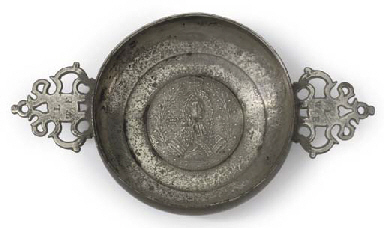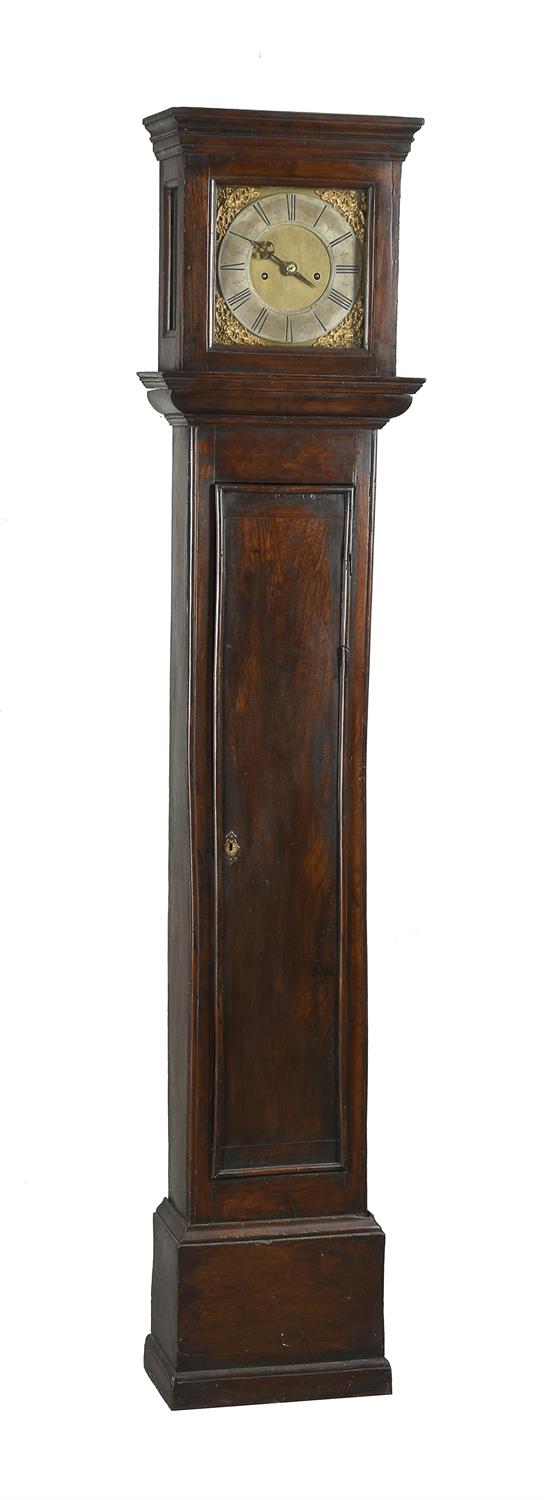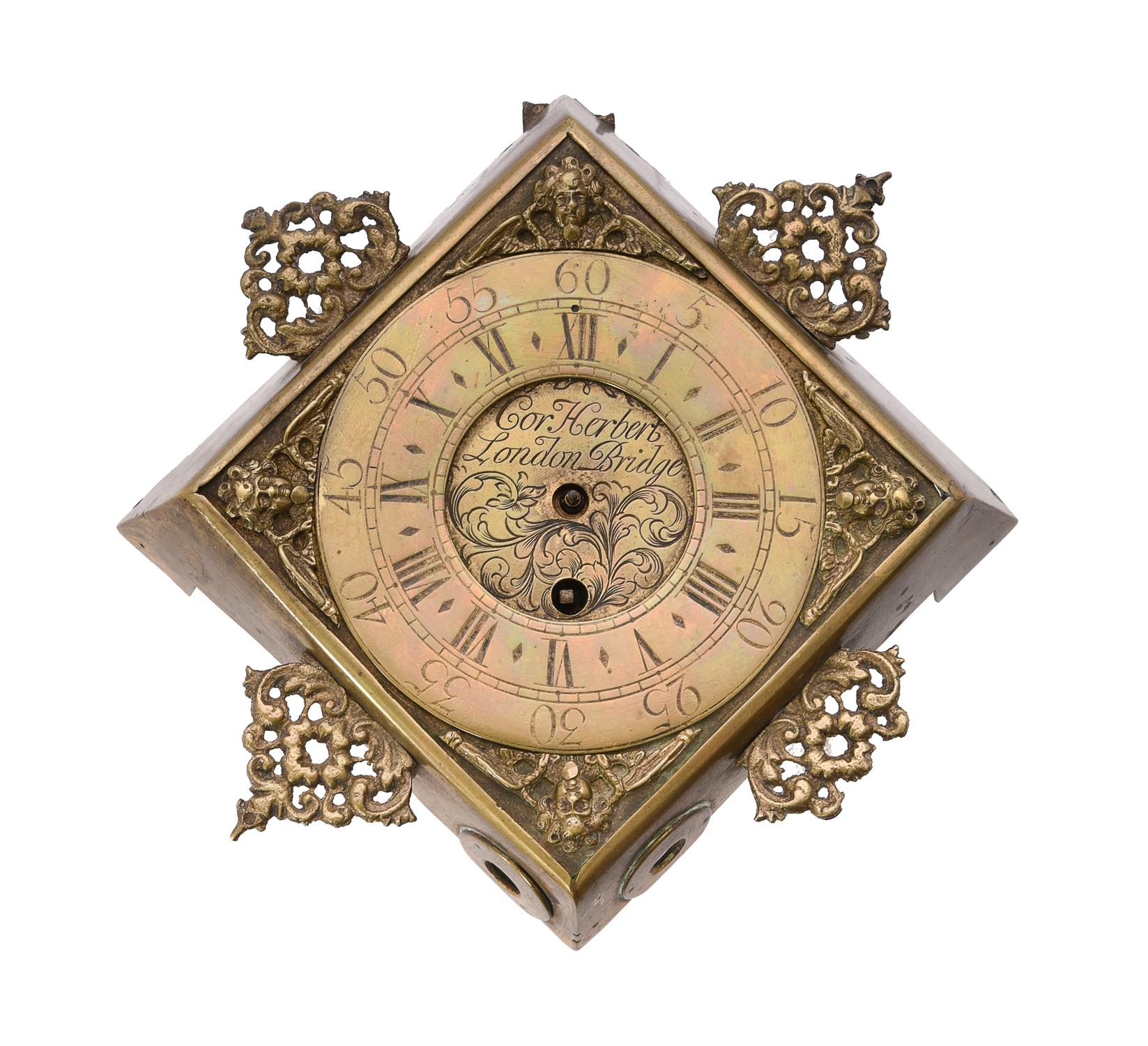A rare William III ebonised thirty-hour longcase clock Thomas Baddely, Bath, circa 1695 The posted countwheel bell striking movement constructed with square section posts with swollen caps and bases riveted to both the top and bottom plates and with movement bars secured via pins against lugs rivetted to the underside of the top plate, the delicate wheelwork with fine 'golf tee' shaped arbors and early pattern escapement pallets, the 10.75 inch square brass dial with fine pierced steel hand and matted centre within applied silvered Roman numeral chapter ring with stylised sword hilt half hour markers and signed Tho: Baddely, Bath to lower margin, the angles applied with winged cherub head and foliate scroll cast spandrels, the case with shallow ogee moulded caddy and ball finial above cavetto moulded dentil cornice and large glazed side apertures to hood, convex throat and rectangular door centred with a glazed lenticle to trunk, on plinth base with moulded skirt, 217cm (85.5ins) high excluding finial, 224cm (88ins) high overall. A Thomas Bad(d)eley is recorded in White, Ian WATCH AND CLOCK MAKERS IN THE CITY OF BATH as working in Bath during the early 18th century. The movement of the current lot is notable for the quality of the wheelwork in particular the turning of the arbors. The method for securing the movement bars within the frame via pins against lugs riveted to the underside of the top plate is rare, but most often seen on clocks made in Somerset during the latter years of the 17th century by makers such as Lawrence Debnam and James Delance of Frome and Edward Webb and Edward Bilbie of Chewstoke. These details coupled with the style of half hour markers, hand and spandrels would suggest that the current lot was made prior to 1700 thus is perhaps one of the earliest surviving clocks made in the city of Bath. IMPORTANT NOTES REGARDING THE CATALOGUING OF CLOCKS Movements, dials and cases: movements and dials are described as relating to the cases in which they are housed in one of the following three ways: the case.... we are of the opinion that the movement and dial started life in the current case. in a case... we are of the opinion that the movement and dial are in a case of correct period and type (and may well be original to the movement and dial), however there is evidence to suggest that they may not have started out life together. now in a case... we are of the opinion that the movement and dial are no longer in the original case or one of correct period and/or type. Pendulums, weights, winding and case keys: unless specifically indicated otherwise in the catalogue description it can be assumed that all clocks with cases are sold with the requisite pendulum and correct number of weights (where appropriate), however we cannot guarantee that they are original to the clock. We do not indicate in the catalogue description whether winding or case keys are present with any specific clock. As many clocks are consigned without keys please check with the department to establish whether they are present or not prior to bidding. Condition: due to the mechanical nature of clocks and the fact that most are of great age we cannot offer any guarantee as to whether they are in working order or free from major faults or restoration. Although we endeavour to catalogue items in a fair and informed manner, omission of any comments or observations regarding the condition or originality of a clock in the description does not necessarily indicate that it is free from significant faults, restoration or is in working condition. We would strongly advise any prospective purchaser to view the item in person or request a condition report and/or further images prior to bidding. Measurements: dial measurements are given in inches, other dimensions such as height are given in centimetres and inches. The measurement given for the height of a longcase clock excludes any removable finials in order to provide an approximate minimum ceiling height
A rare William III ebonised thirty-hour longcase clock Thomas Baddely, Bath, circa 1695 The posted countwheel bell striking movement constructed with square section posts with swollen caps and bases riveted to both the top and bottom plates and with movement bars secured via pins against lugs rivetted to the underside of the top plate, the delicate wheelwork with fine 'golf tee' shaped arbors and early pattern escapement pallets, the 10.75 inch square brass dial with fine pierced steel hand and matted centre within applied silvered Roman numeral chapter ring with stylised sword hilt half hour markers and signed Tho: Baddely, Bath to lower margin, the angles applied with winged cherub head and foliate scroll cast spandrels, the case with shallow ogee moulded caddy and ball finial above cavetto moulded dentil cornice and large glazed side apertures to hood, convex throat and rectangular door centred with a glazed lenticle to trunk, on plinth base with moulded skirt, 217cm (85.5ins) high excluding finial, 224cm (88ins) high overall. A Thomas Bad(d)eley is recorded in White, Ian WATCH AND CLOCK MAKERS IN THE CITY OF BATH as working in Bath during the early 18th century. The movement of the current lot is notable for the quality of the wheelwork in particular the turning of the arbors. The method for securing the movement bars within the frame via pins against lugs riveted to the underside of the top plate is rare, but most often seen on clocks made in Somerset during the latter years of the 17th century by makers such as Lawrence Debnam and James Delance of Frome and Edward Webb and Edward Bilbie of Chewstoke. These details coupled with the style of half hour markers, hand and spandrels would suggest that the current lot was made prior to 1700 thus is perhaps one of the earliest surviving clocks made in the city of Bath. IMPORTANT NOTES REGARDING THE CATALOGUING OF CLOCKS Movements, dials and cases: movements and dials are described as relating to the cases in which they are housed in one of the following three ways: the case.... we are of the opinion that the movement and dial started life in the current case. in a case... we are of the opinion that the movement and dial are in a case of correct period and type (and may well be original to the movement and dial), however there is evidence to suggest that they may not have started out life together. now in a case... we are of the opinion that the movement and dial are no longer in the original case or one of correct period and/or type. Pendulums, weights, winding and case keys: unless specifically indicated otherwise in the catalogue description it can be assumed that all clocks with cases are sold with the requisite pendulum and correct number of weights (where appropriate), however we cannot guarantee that they are original to the clock. We do not indicate in the catalogue description whether winding or case keys are present with any specific clock. As many clocks are consigned without keys please check with the department to establish whether they are present or not prior to bidding. Condition: due to the mechanical nature of clocks and the fact that most are of great age we cannot offer any guarantee as to whether they are in working order or free from major faults or restoration. Although we endeavour to catalogue items in a fair and informed manner, omission of any comments or observations regarding the condition or originality of a clock in the description does not necessarily indicate that it is free from significant faults, restoration or is in working condition. We would strongly advise any prospective purchaser to view the item in person or request a condition report and/or further images prior to bidding. Measurements: dial measurements are given in inches, other dimensions such as height are given in centimetres and inches. The measurement given for the height of a longcase clock excludes any removable finials in order to provide an approximate minimum ceiling height














Testen Sie LotSearch und seine Premium-Features 7 Tage - ohne Kosten!
Lassen Sie sich automatisch über neue Objekte in kommenden Auktionen benachrichtigen.
Suchauftrag anlegen